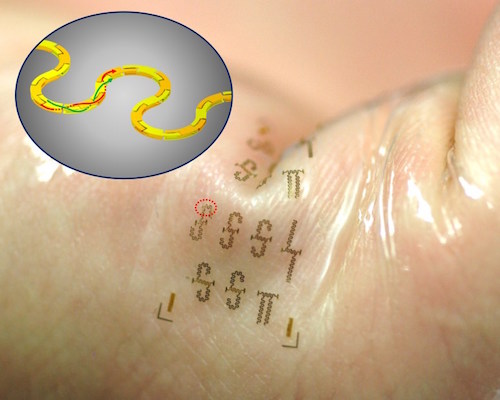University of Wisconsin-Madison scientists have created the world’s fastest stretchable, advanced wearable integrated circuits that shall push the Internet of Things (IoT) to a much more connected space. The platform that has been developed by these engineers may help manufacturers further the capabilities and applications of wearable electronics – including biomedical applications – using the new wireless broadband technology 5G.
With wavelength sizes varying from a millimetre to a metre, microwave radio frequencies are electromagnetic waves that use frequencies between 0.3 gigahertz to 300 gigahertz, a range that directly falls under 5G. In coming days, the wide microwave frequencies of 5G networks will connect a rapidly growing number of mobile phone users and shall also result in a significant increase in data speeds and coverage areas.

In an Intensive Care Unit (ICU), epidermal electronic unis (electronics that stick to the skin like temporary tattoos) may allow health care staff to monitor their patients wirelessly and remotely, thus increasing patient convenience by totally removing the hassle of going through a variety of cables and wires every time for health check. While this application has been studied and brought to fore a lot many times earlier, what makes it specially unique and powerful here is that the new, stretchable integrated circuits have a special structure inspired by twisted-pair telephone cables.
These circuits accommodate two ultra-tiny intertwining power transmission lines in repeating S-curves. These serpentine shape formed in two layers by segmented metal blocks like a 3D puzzle provides the transmission lines with an ability to stretch without affecting their performance. It even helps shield the lines from external interference and simultaneously confines the electromagnetic waves flowing through them, almost entirely elimination current loss. As of now the researchers’ stretchable integrated circuits can work at a radio frequency up to 40 gigahertz.
Unlike other stretchable transmission lines, whose thickness may go up to 640 micrometers, the new stretchable integrated circuits are just 25 micrometres wide – a size tiny enough to be employed in epidermal electronic systems among several other applications. Zhenqiang “Jack” Ma, team leader of this project, stated that the team has found a way to integrate high-frequency active transistors into a useful circuit that can have wireless capabilities.
This study was published in Advanced Functional Materials journal.
via: wisc.edu
University of Wisconsin-Madison scientists have created the world’s fastest stretchable, advanced wearable integrated circuits that shall push the Internet of Things (IoT) to a much more connected space. The platform that has been developed by these engineers may help manufacturers further the capabilities and applications of wearable electronics – including biomedical applications – using the new wireless broadband technology 5G.
With wavelength sizes varying from a millimetre to a metre, microwave radio frequencies are electromagnetic waves that use frequencies between 0.3 gigahertz to 300 gigahertz, a range that directly falls under 5G. In coming days, the wide microwave frequencies of 5G networks will connect a rapidly growing number of mobile phone users and shall also result in a significant increase in data speeds and coverage areas.
In an Intensive Care Unit (ICU), epidermal electronic unis (electronics that stick to the skin like temporary tattoos) may allow health care staff to monitor their patients wirelessly and remotely, thus increasing patient convenience by totally removing the hassle of going through a variety of cables and wires every time for health check. While this application has been studied and brought to fore a lot many times earlier, what makes it specially unique and powerful here is that the new, stretchable integrated circuits have a special structure inspired by twisted-pair telephone cables.
These circuits accommodate two ultra-tiny intertwining power transmission lines in repeating S-curves. These serpentine shape formed in two layers by segmented metal blocks like a 3D puzzle provides the transmission lines with an ability to stretch without affecting their performance. It even helps shield the lines from external interference and simultaneously confines the electromagnetic waves flowing through them, almost entirely elimination current loss. As of now the researchers’ stretchable integrated circuits can work at a radio frequency up to 40 gigahertz.
Unlike other stretchable transmission lines, whose thickness may go up to 640 micrometers, the new stretchable integrated circuits are just 25 micrometres wide – a size tiny enough to be employed in epidermal electronic systems among several other applications. Zhenqiang “Jack” Ma, team leader of this project, stated that the team has found a way to integrate high-frequency active transistors into a useful circuit that can have wireless capabilities.
This study was published in Advanced Functional Materials journal.
via: wisc.edu